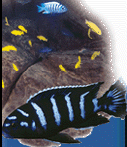

AFRIČKI CIKLIDI
Fossorochromis
|
Fossorochromis Trewawas 1989Fossorochromis rostratus Boulenger 1898 Original Description:
The genus Fossorochromis was erected by Ethelwyn Trewawas and David H. Eccles in 1989 (Eccles and Trewawas, 1989) as one of their new 39 genera erected to classify Malawian haphlochromines. Fossorochromis was created to accomodate one single monotypic species endemic of lake Malawi, Africa, Fossorochromis rostratus. The diagonsis of this genus, whose name stems from the latin "Fossor" meaning digger, is described as a "melanin pattern, which consists of a series of bold dark spots along the middle of the flank from above the pelvic fins to the end of the caudal penduncle, a second series along or above the upper lateral line and a third at the base of the dorsal fin. Snout rather long, equal to or longer than postorbital part of the head". Fossorochromis rostratus, the type monotypic species, was first described by Boulenger in 1899 as Tilapia rostrata, later in 1922 was reclassified as Haplochromis by Regan (Regan 1922). Synonymy includes Haplochromis macrorhynchus Regan 1922, which appeared to have a different number of gill-rakers, but "the differences in the shape of the snout and the slope of the mouth show no constant correlation with gill-raker number, although this appeared to be the case in the small samples available to Regan" (Eccles and Trewawas, 1989). Fossorochromis rostratus males lack the egg spots always present in the anal fins of Haplochromines with a sand nest (Konings 1996). Fossorochromis rostratus is common off sandy beaches, apparently does not extend to a depth of 18 m. It feeds in groups of up to fifty individuals by plunging its snout into the sand, apparently sifting out small invertebrates from the sand, which it filters through the gills. Large specimens are often accompanied by small individuals of Cyrtocara moorii which appear to take particles from the cloud of material passed over the gills (Fryer & Iles,1972; Konings 1996). Africans name this fish "Chimbenje" (A sly person). It has been given this distinction because it is able to avoid the seine nets of the local fishermen by burying itself in the sand, juveniles as well use this tactic in order to escape pedrators (Konings 1996).
References
|